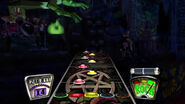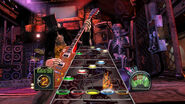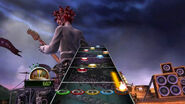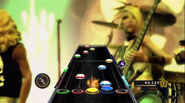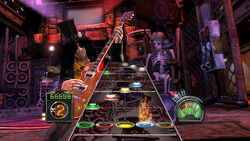
2 strum notes (gems notes with black rings on top) and 6 HOPO notes (gem notes with a glowing white top) shown on screen in Guitar Hero III: Legends of Rock.
Hammer-ons and Pull-offs are a type of notes in the Guitar Hero series of games. Many fans know these by their abbreviations, HOs and POs, or, more commonly, HOPOs. Although labeled as advanced per se, it is relatively easy to learn how to perform the technique, but to master it is a totally different story. Indeed, in order to perform the insane solos that the game sends at the player, HOs and POs are not only recommended, but essential.
They can be identified by the glow on the gem notes. In most Guitar Hero games, they have a white glow on top without the usual black ring around it. In Guitar Hero Live, HOPOs have a cyan glow around the notes/bar chords.
How to perform the technique[]
When a close set of notes is approaching on-screen (usually less than an eighth note distance apart), rather than strumming each note individually as normal, you flip the strum bar up or down for the first note (the "strum note"), then finger the other frets on the glowing HOPO notes, but you do not have to strum all the notes; the notes still "play" as usual. To "hammer-on" means to perform this technique starting out with a lower note, and usually ending the note sequence in a higher note.
An example would be a three note sequence of G→R→Y. You would strum the green note as normal, but use the above technique to "nail" the red and yellow notes or "hammer-on" them. To "pull-off" is to use the same technique once again, but in reverse. Usually, a pull-off begins with a high note, and ends in a lower note. An example would be a three note sequence of B→Y→R. By strumming the blue note as normal, you "pull-off" from it and finger the lower notes in the sequence.
You must be in a combo (minimum note streak of 1) to be able to play a HOPO note without strumming. If your combo breaks during a session of HOPO notes, you must strum the a HOPO note to get back into combo so you can tap the rest.
Once learned, and eventually mastered, the techniques greatly reduce difficulty later on in the game, especially on Expert difficulty.
When to use[]
Before Guitar Hero III: Legends of Rock, hammer-ons and pull-offs are not able to be performed simply due to the fact that notes in a sequence must be "close" together on the fret board; the technique can not be used on notes too far apart. Therefore, because of the slower speed of Easy and Medium, opportunities to use HOs and POs are almost nonexistent, although the ending of "Sweet Home Alabama" for the Bass in Guitar Hero World Tour features numerous HOs and POs even on Easy. However, when playing songs on Hard and Expert, HOPO sequences are often in abundance, and as stated before, are many times essential to nail insane solos; to strum each note in fast sequences and solos seen often in Expert would be tedious and reduce the likelihood of hitting the majority of the notes; in rarer instances, it is downright improbable to be able to strum each note individually.
HO and PO sequences vary in length; some can be simple two note patterns, such as in the intro of "Billion Dollar Babies" on the Xbox 360 version of Guitar Hero II; others can be six, seven, even ten notes or more. A very skilled player can often hit dozens of notes coming down the fret board using solely HOs and POs. Some songs, such as "Jordan" on Expert are indeed impossible to pass without skill in performing these techniques. Each player often is able to see what works for them, growing comfortable with how often and when they use HOs and POs.
Mechanics and technicalities[]
HO and PO sequences are handled differently in the first Guitar Hero compared with the rest of the series—they play closer to the way they would on a real guitar, making them more realistic but far harder.
Consider a sequence G→R→Y. In the first Guitar Hero, hammering on this sequence would require you to strum the green note, then press the red while still holding the green, then press the yellow while still holding at least the red and most likely also the green. Starting in the second game Guitar Hero II and every other Guitar Hero game, you can strum the green, then release it and press the red, then release that and press the yellow. Conversely, a Y→R→G sequence would need to be played as a strum with yellow, red and green all held, then release the yellow, then release the red; in later versions you can simply press the yellow, then press the red, then press the green. This has considerable consequences. It's these differences that make "Bark At The Moon" difficult in the first Guitar Hero game (but easier in the second game as DLC), and also renders tapping virtually impossible.
A trick to somewhat fix this in a long sequence is to strum the first few notes and hammer-on the rest. This makes the timing window larger somehow.
HOPO chords[]

A 3-note GRY HOPO chord in the Guitar Hero 5 song "Du Hast".
Introduced in Guitar Hero On Tour: Modern Hits—which was carried over to Guitar Hero 5, Band Hero, Guitar Hero: Warriors of Rock, and Guitar Hero Live—chords, which were previously strum-only notes, now supports HOPO features on them. All frets of a HOPO chord must be tapped simultaneously as the notes touch their targets to play them. Like with single HOPO notes, HOPO chords can optionally be strummed as well.
HOPOs in the same lane?[]

A green HOPO note after a sustained GYB chord strum in "Pride and Joy" on Expert in Guitar Hero: On Tour.
Other than chords to single notes on one of the same lanes (releasing additional fret(s) while keeping the fret of the next note held or re-tap it) or HOPO chords featuring (some) notes of the same lane before it (tap the additional fret(s) while holding the first fret or re-tap the first fret), hammer-ons and pull-offs in majority of the Guitar Hero series will not feature HOPOs on the same consecutive note or chord.

A yellow HOPO note after a yellow strum note in "Pride and Joy" on Expert difficulty in Guitar Hero: On Tour.
However, few songs in the Guitar Hero: On Tour series will feature HOPO notes in the same lane as the previous note. It is unknown whether or not if HOPOs in the same lane in the On Tour series were placed intentionally or accidentally by Vicarious Visions. Examples include:
- "Pride and Joy" on Expert difficulty in Guitar Hero: On Tour has two consecutive HOPO notes during Verse 1.[1]
- A yellow HOPO note after a yellow strum note during Verse 1.
- Two green HOPO notes in a row during Verse 1.

2 green HOPO notes in "Satch Boogie" (English version) in Guitar Hero On Tour: Decades.
- "Satch Boogie" on Expert difficulty in the English version of Guitar Hero On Tour: Decades have three consecutive HOPO notes while the non-English European version of the game has two consecutive HOPO notes.[2]
- Two green HOPO notes in a row before the final solo on Expert.
- The English version of the song on Expert also has a yellow HOPO note at the start of the final solo after the yellow sustained note. The yellow note in the non-English European version is a strum note.
- Two yellow HOPO notes in a row during the final solo.
As long as the player is in a combo, the player can either continue to hold the fret to automatically hit the consecutive HOPO note (if it's nearby in tapping range after the previous note), or releasing and re-tap the same fret button to play HOPO notes in the same lane.
Guitar Hero Live's HOPO mechanics[]
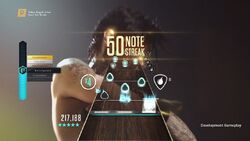
2 strum notes and 6 HOPO notes on screen in Guitar Hero Live.
HOPO notes have a cyan glow around them. Chords and bar chords (2-note chords in the same fret lane) also support the HOPO mechanic.
HOPO notes in Guitar Hero Live can be performed horizontally or vertically up and down. However, when hammering on a note vertically, the opposing note must be not be held. This means that if you are pulling off from a W3 note to a B3 note, the W3 fret must be released. Likewise, if you are pulling off from a B2 note to a W2 note (yes, "pulling off" from a low note to high note, and not "hammering on"), you must release the B2 fret.
Only frets to the left of a HOPO note (regardless if it's white or black) can optionally be held while hammering to a HOPO note vertically or to the right regardless of its shade. Going from high W2→B2 low is pull-off. Going from low B2→W2 high is also pull-off (the B2 fret must be released). Going from the high note W3→B2 low note is a pull-off. Going from the low note B3→W1 high note is also a pull-off (you can hold a W1 while strumming B3). Only the number value of the fret matters if it could be treated as a hammer-on (from a lesser number to a higher number) or a pull-off (same number or lower) regardless of its shade.
Arpeggio tips: When playing a reversed arpeggio (playing extended sustains from right to left with nearby HOPO notes less regardless if they are black or white white as long as it's from right to left, such as B3→W2→B1 or W3→B2→W1), all corresponding frets can optionally be held before strumming the first note and all notes will register in the game as they pass the target line.
Gallery[]
Videos[]
External Links[]
See also[]
References[]
- ↑ YouTube — Guitar Hero On Tour - "Pride and Joy" Expert Guitar 100% FC (373,305) by guitarheroROXS, posted on May 30, 2023 (0:46 for yellow HOPO note, 1:03 for green HOPO note)
- ↑ YouTube — "Satch Boogie" US/UK vs. EU Chart Comparison (Expert Guitar) - Guitar Hero On Tour Decades by guitarheroROXS, posted on July 10, 2023 (1:50 for green HOPO note, 1:57 for yellow HOPO note, 2:03 for another yellow HOPO note)

